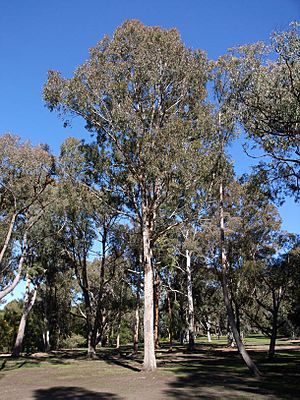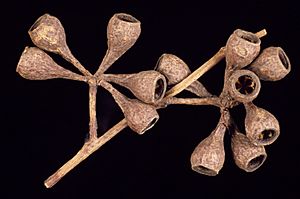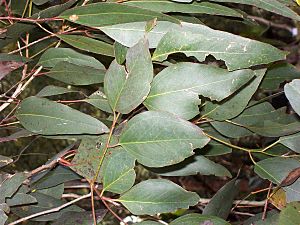Coast grey box facts for kids
Quick facts for kids Coast grey box |
|
|---|---|
 |
|
| Eucalyptus bosistoana in the ANBG | |
| Scientific classification | |
| Genus: |
Eucalyptus
|
| Species: |
bosistoana
|
The Eucalyptus bosistoana, often called the coast grey box or Bosisto's box, is a type of tree. It grows only in south-eastern Australia. This tree has rough, flaky bark near the bottom of its trunk. Higher up, the bark is smooth and can be cream, yellow, or grey. This smooth bark often peels off in long strips.
Its adult leaves are shaped like a spear or are slightly curved. The flower buds grow in groups of seven. When the flowers bloom, they are white. After flowering, the tree produces fruit that looks like a cup, barrel, or half-sphere. These fruits are called capsules.
What Does It Look Like?
The coast grey box is the biggest of the "box" eucalypt trees. It can grow very tall, up to 60 meters (about 200 feet). Its trunk can be at least 1.5 meters (about 5 feet) wide. This tree also has a special woody swelling at its base called a lignotuber. This helps the tree regrow if it gets damaged, for example, by fire.
The bark on the lower part of the trunk is thin, rough, and brownish-grey. The bark higher up and on the branches is smooth. It can be white, cream, or grey and peels off in ribbons. Sometimes, the entire tree has smooth bark.
Young plants and new shoots (called coppice regrowth) have round stems. Their leaves are oblong or egg-shaped and pale green. These young leaves are about 30-70 mm long and 18-33 mm wide. They grow on a small stalk called a petiole.
Adult leaves are shaped like a spear or are slightly curved. They are the same color on both sides. These leaves are usually 58-200 mm long and 7-27 mm wide. Their petioles are about 10-18 mm long.
The flower buds usually grow in groups of seven. They appear where the leaf meets the stem (this spot is called an axil). Each group of buds grows on a main stalk called a peduncle, which is about 7-10 mm long. Each individual bud has its own smaller stalk, called a pedicel, about 3-8 mm long.
Mature buds are oval-shaped, about 6-8 mm long and 3-5 mm wide. They have a cap-like top called an operculum, which can be cone-shaped or rounded. The tree mainly flowers from January to April, and its flowers are white.
After the flowers, the tree produces fruit. These fruits are cup-shaped, barrel-shaped, or half-sphere shaped. They are about 4-8 mm long and wide. Each fruit sits on a pedicel about 4-7 mm long. The parts that open to release seeds (called valves) are usually level with the rim of the fruit or hidden inside.
Name and History
The Eucalyptus bosistoana was first officially described in 1895. This description was made by a scientist named Ferdinand von Mueller. He published it in a journal called the Australasian Journal of Pharmacy.
The second part of its scientific name, bosistoana, was chosen to honor Joseph Bosisto. He was one of the first people in Australia to extract essential oils from plants. He was especially known for making eucalyptus oil.
Where It Grows
The coast grey box tree grows in New South Wales and Victoria. You can find it as far north as the Wolgan Valley, which is west of Sydney. It also grows as far south as eastern Gippsland.
This tree prefers to grow near streams in low-lying areas. It likes good quality soils, especially those over limestone. However, you might also see it on higher lands, called tablelands, up to 500 meters (about 1,640 feet) above sea level. For example, it grows near Goulburn and Bungonia.
The Eucalyptus bosistoana often grows alongside other types of trees. Some of these include E. cypellocarpa, E. longifolia, E. paniculata, and Casuarina cunninghamiana.
How People Use It
The wood from the coast grey box is very useful. It is known to be strong and resistant to termites, which are tiny insects that can damage wood. However, it can be affected by lyctus borers, another type of wood-eating insect.
This timber is highly valued for heavy construction projects. Its wood has an "interlocked grain," meaning the wood fibers grow in different directions, making it very strong. People use it for building, making large poles, and for railway sleepers (the wooden beams that support train tracks). It is a very durable wood, meaning it lasts a long time. It is also quite heavy, weighing about 1100 kilograms per cubic meter.




